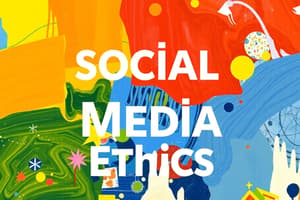Podcast
Questions and Answers
What is the primary function of opinion leaders in the two-step flow model?
What is the primary function of opinion leaders in the two-step flow model?
- Serve as a link between media messages and the public (correct)
- Disseminate fake news to the public
- Restrict information flow to ensure media quality
- Generate media content for social media
Which of the following is NOT a characteristic of ethical media?
Which of the following is NOT a characteristic of ethical media?
- Ensures high-quality content
- Focuses only on profit maximization (correct)
- Protects user privacy
- Promotes the common good
How do new media differ from legacy media?
How do new media differ from legacy media?
- New media have stricter regulations on content
- New media involve greater interactivity and mobility (correct)
- New media rely solely on traditional advertising methods
- New media are primarily focused on advocacy rather than information
What role does newsworthiness play in media content?
What role does newsworthiness play in media content?
What does McLuhan's metaphor of 'Media as a Global Village' imply?
What does McLuhan's metaphor of 'Media as a Global Village' imply?
What role do early adopters play in the diffusion of innovations model?
What role do early adopters play in the diffusion of innovations model?
Which theory suggests that media messages have a direct effect on the audience?
Which theory suggests that media messages have a direct effect on the audience?
What is NOT considered an essential quality of journalism?
What is NOT considered an essential quality of journalism?
Which of the following is a stage in the diffusion process?
Which of the following is a stage in the diffusion process?
What does the acronym T.R.U.T.H in journalism stand for?
What does the acronym T.R.U.T.H in journalism stand for?
What is the main consequence of a lack of trustworthiness in journalism?
What is the main consequence of a lack of trustworthiness in journalism?
Which group in the diffusion of innovations model is likely to be skeptical and resistant to change?
Which group in the diffusion of innovations model is likely to be skeptical and resistant to change?
What is defined as new facts and events that impact our lives?
What is defined as new facts and events that impact our lives?
Flashcards
Newsworthiness
Newsworthiness
Media outlets, like newspapers and radio, actively choose what gets reported, highlighting specific events deemed significant, thus influencing public perception.
Two-Step Flow Model
Two-Step Flow Model
The spread of information through society, starting with opinion leaders who receive it first from media and then share it with the public.
Media as a Global Village
Media as a Global Village
Media has brought the world closer together, connecting people across distances through shared experiences and information access.
Ethical Media
Ethical Media
Signup and view all the flashcards
Legacy Media vs. Social Media
Legacy Media vs. Social Media
Signup and view all the flashcards
Social construction of news
Social construction of news
Signup and view all the flashcards
Media Effects
Media Effects
Signup and view all the flashcards
Selective Exposure Theory
Selective Exposure Theory
Signup and view all the flashcards
Diffusion of Innovations Model
Diffusion of Innovations Model
Signup and view all the flashcards
Innovators (Diffusion of Innovations)
Innovators (Diffusion of Innovations)
Signup and view all the flashcards
Early Adopters (Diffusion of Innovations)
Early Adopters (Diffusion of Innovations)
Signup and view all the flashcards
What is Journalism?
What is Journalism?
Signup and view all the flashcards
Fact-Checking
Fact-Checking
Signup and view all the flashcards
Study Notes
Media, Culture, and Society
- Media reflects opinions, but isn't a perfect reflection of reality. It has responsibilities as a business.
- Social media differs from legacy media, with social media potentially including "fake news" as an industry practice, unlike legacy media which often prohibits it.
- The two-step flow model describes how media messages spread through opinion leaders.
- The media acts as a global village, connecting people worldwide through shared experiences and information.
- Media content includes many forms, such as entertainment, advocacy, advertisements, and news.
- Ethical media promotes solidarity, the right to information, and the common good, while protecting privacy and individual rights.
- New media brings digitalization, increased interactivity, mobility in communication, and network connectivity, changing the roles of publication and audiences.
Political System
- Media content reflects its financial backers.
- Newsworthiness is socially constructed, with news organizations deciding what's important.
- Media affects opinions and potentially leads to change.
- Credibility, media coverage extent, critical reading, and public opinion about a topic all influence the media's effect on people.
- Various media theories, such as two-step flow, hypodermic, and selective exposure, explain how media messages impact audiences.
- The diffusion of innovations model describes how new ideas or products spread through societies. It includes innovators, early adopters, early majority, late majority, and laggards, who adopt innovations at differing points.
Journalism
- Journalism is the practice of gathering, assessing, and presenting news to the public. It's characterized by transparency, objectivity, and accuracy.
- Newsworthy events are those that impact lives and are significant enough to be reported.
- Journalists act as verifiers, sense-makers, and witnesses, employing investigation and experience to report the truth.
- News must be timely, relevant, unusual, present tension/trouble, and have human interest.
- The T.R.U.T.H acronym defines timely, relevant, unusual, tension/trouble and human interest facets of newsworthiness.
- Fact-checking is crucial for trustworthy journalism to maintain credibility and integrity.
- Trustworthiness is essential for journalism, as the public relies on accurate and balanced reporting.
Studying That Suits You
Use AI to generate personalized quizzes and flashcards to suit your learning preferences.



